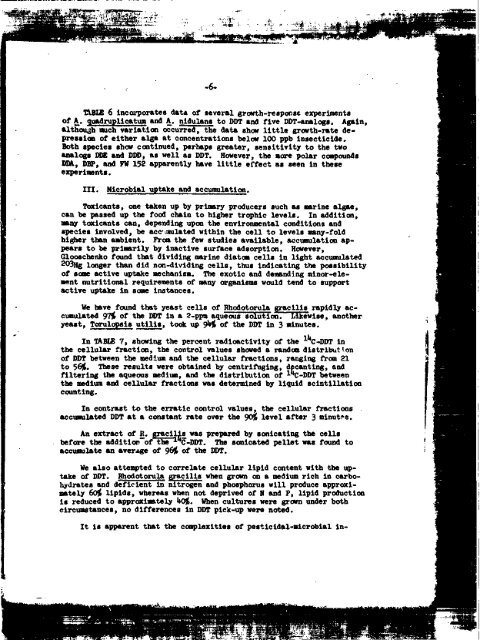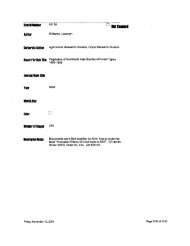Item ID Number - Special Collections
Item ID Number - Special Collections
Item ID Number - Special Collections
You also want an ePaper? Increase the reach of your titles
YUMPU automatically turns print PDFs into web optimized ePapers that Google loves.
-6-<br />
TABUE 6 Incorporates data of several growth-response experiments<br />
of A. quadruplicatum and A. nidulans to DDT and five DDT-analogs. Again,<br />
although much variation occurred, the data show little growth-rate depression<br />
of either alga at concentrations below 100 ppb insecticide.<br />
Both species show continued, perhaps greater, sensitivity to the two<br />
analogs DDE and ODD, as well as DDT. However, the more polar compounds<br />
DDA, DBF, and FW 152 apparently have little effect as seen in these<br />
experiments.<br />
III.<br />
Microbial uptake and accumulation.<br />
Toxicants, one taken up by primary producers such as marine algae,<br />
can be passed up the food chain to higher trophic levels. In addition,<br />
many toxicants can, depending upon the environmental conditions and<br />
species involved, be accumulated within the cell to levels many-fold<br />
higher than ambient. From the few studies available, accumulation appears<br />
to be primarily by inactive surface adsorption. However,<br />
Glooschenko found that dividing marine diatom cells in light accumulated<br />
2 °3Hg longer than did non-dividing cells, thus indicating the possibility<br />
of some active uptake mechanism. The exotic and demanding minor-element<br />
nutritional requirements of many organisms would tend to support<br />
active uptake in some instances.<br />
We have found that yeast cells of Rhodotorula gracilis rapidly accumulated<br />
yii> of the DDT in a 2-ppm aqueous solution! Likewise, another<br />
yeast, Torulopsis utilis, took up 9^6 of the DDT in 3 minutes.<br />
In TABLE 7, showing the percent radioactivity of the ^C-DDT in<br />
the cellular fraction, the control values showed a random distribution<br />
of DDT between the medium and the cellular fractions, ranging from 21<br />
to 56£. These results were obtained by centrifuging, decanting, and<br />
filtering the aqueous medium, and the distribution of i^C-DDT between<br />
the medium and cellular fractions was determined by liquid scintillation<br />
counting.<br />
In contrast to the erratic control values, the cellular fractions<br />
accumulated DDT at a constant rate over the
















